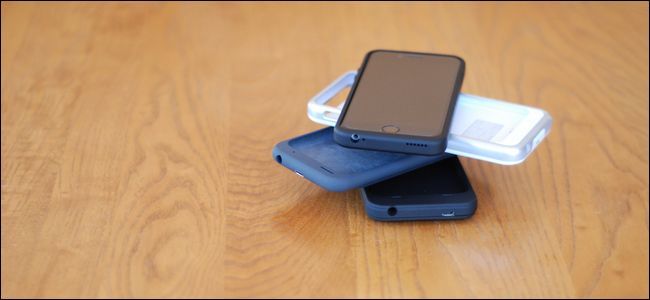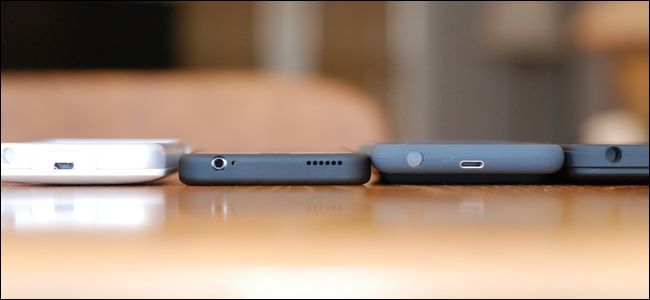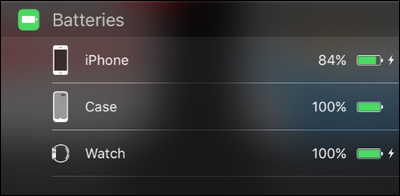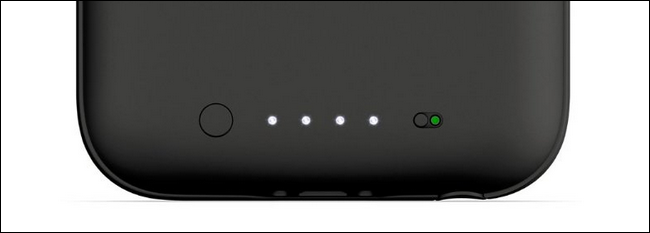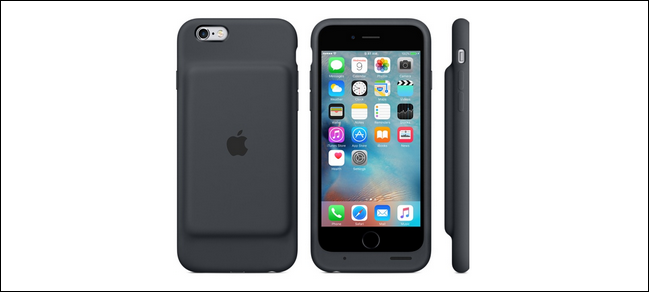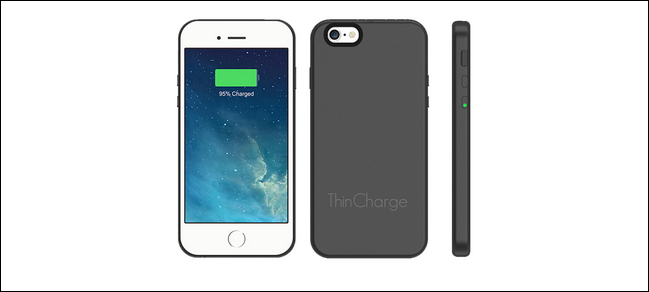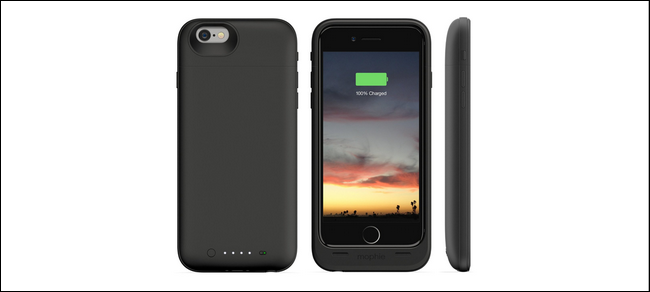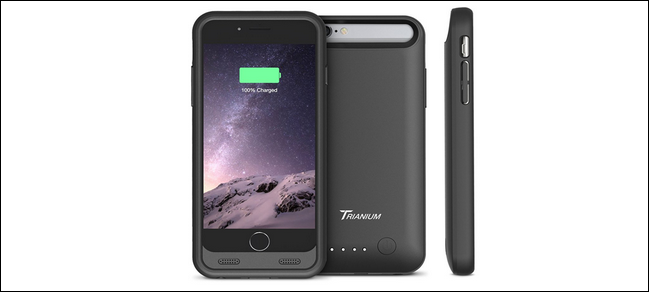Quick Links
iPhone battery life has increased significantly over the last few years, but it's still possible to find yourself staring at a depleted battery by the end of the day. Extend the time between charges with the right battery case.
Battery Cases Are Underrated
There's a long running complaint among a not-so-small number of iPhone users that goes something like: "I don't want a thinner iPhone, I want better battery life!" Now, in fairness, the iPhone's battery life has increased over the years but the point still stands: if they made fatter iPhones, they could have both more efficient batteries and be more durable.
iPhone battery cases allow you to choose which of those you want! You want a skinny phone? Don't bother with a case. You want a fatter phone with multi-day battery life? Slap on a battery case.
No matter what your battery-killing problem--skipping between cellphone towers on the commuter train, playing graphic-intensive games on long flights, taking advantage of your unlimited talk time--the right battery case can solve it by pumping auxiliary juice into your iPhone. In fact, with the right battery case, you can extend the already great iPhone battery life nearly threefold. With battery life that great, you'll never need to make eye contact with another person on your daily commute again. Ever.
Not all iPhone battery cases are created equal, however, so let's take a look at all the factors you'll want to consider when case shopping.
How to Select the Right iPhone Battery Case
When you select a regular phone case, you make all sorts of trade-offs. If you want to preserve the look of your iPhone, then you're stuck using very thin cases which offer less protection. If you want to protect your iPhone against a hard fall on a ceramic tile floor, or a plunge into your swimming pool, you're stuck slapping a bulky case on it.
Selecting a battery case is exactly the same: you'll make trade-offs based on the features that are the most important to you. Let's run through battery-case specific features you'll want to weigh when making your case purchase.
More Milliamps Means More Playtime
First, a word on terminology. Mobile battery capacity is measured in milliamp-hours (mAh). For frame of reference, the iPhone 6 has a battery capacity of 1810mAh, and the iPhone 6s has a slightly reduced capacity of 1715 mAh. When shopping for an iPhone battery case you want to keep those values in mind as they give you a rough guideline of how much a battery pack will extend the life of your iPhone between charges.
If, for example, in a typical day you get about 7 hours of use out of your phone (this amount will vary wildly between people), then it is safe to assume that a ~1,800 mAh battery case will roughly double your use time to 14 hours. Whatever percent-increase the mAh capacity of the case can safely be assumed to be the general percent-increase you'll see in your general battery life.
Capacity Comes at a (Bulky) Cost
Despite advances in battery technology, batteries have heft, and higher capacity batteries have even bigger heft. The more mAh a battery case has, the bulkier the case will be. As a general rule of thumb, you should assume that a battery case will increase the general weight and volume of your iPhone by 100-200%.
This seems like a huge increase when written out as a percent value, but in practice it's really not that big of a deal--especially if you're one of those people that isn't a huge fan of how skinny the iPhone has become. That said, if you want battery life with a more slender profile, be prepared to pay more (and get less of a battery boost).
Charging Methods and Data Syncing Can Be Deal Breakers
The majority of iPhone battery packs on the market charge via micro USB cable. For a lot of iPhone owners (who have got away from using micro USB and prefer Apple's lightning cables) this is an annoyance at best, and a deal breaker at worst.
You'll also need to consider pass-through charging. Cheaper battery cases don't offer pass-through charging, so in order to charge your iPhone each night, you have to take the case off. Better cases do offer pass-through charging, charging the iPhone first, then the battery pack.
Although this is less important to a lot of people these days (as the popularity of iCloud has cut down on manual cable-based data syncing) the final cable-related consideration is whether or not the case supports data pass-through. Again, higher end cases will support it--so you can both charge and sync your phone with the port--but cheaper cases won't.
Capacity Indicators Help You Check Remaining Charge
There is a very wide range of case capacity indicator styles. Apple's official iPhone battery case does it best in that it, actually puts the capacity of both the phone and the battery case right on your screen, inside iOS. In terms of battery indicators, it doesn't get much better than that.
Every other case on the market displays remaining battery-case life in different ways--none of which, unfortunately, include on-screen indicators. Some cases have a single LED indicator in the case's power button, some go for the indicator bar look with a series of 3-4 small LEDs across the bottom of the case, and so on.
As long as the indicator gives you at least some sort of feedback as to how much capacity is left, however, it should suffice.
Our Recommendations
When we write guides like this, we always start by explaining the general concepts you should look for while shopping, but we completely understand that many readers simply want a good recommendation. To that end, let's highlight a few high quality iPhone 6/6s cases for your consideration. Note that because of the identical body size and button/port placement cases for the iPhone 6 and 6s are interchangeable.
Although a lot of people were disappointed by the ugly bump-on-the-back form factor, it's tough to go wrong with the official Apple iPhone battery case ($99). Despite people complaining about the $99 price tag, the going rate for a premium iPhone battery case is, across the third-party vendor spectrum, about a hundred bucks, so Apple's about average here.
The Apple case offers 1877 mAh capacity, pass-through charging and data syncing via (of course) a lightning cable, and--as we noted above--it's the only iPhone battery case that can provide on-screen battery life. If you don't mind the odd looks-like-a-2005-era-extended-smartphone-battery bump on the back, it's a very solid option.
If you're put off by the bump on the Apple case but you still want a slim and good looking case, we'd encourage you to check out the Thin Charge ($129). Out of all the battery cases we tested, this one was our favorite, far and away. It is, as the name implies, incredibly thin. It only bumps the width of the iPhone out a scant 2mm (which is on par with a lot of non-battery cases). We really can't emphasize enough how little ThinCharge feels like just a regular sturdy case and not a bulky battery add-on.
It offers pass-through data and charging via lightning cable and, thanks to a charge-from-the-top design that shifts the charting port to the top of the case, it actually has a much smaller profile than any other case (Apple's included). Aside from the modest increase in weight, it's practically impossible to tell it apart from another case. And at 2,600 mAh it more than doubles the battery life.
A long standing favorite in the market, Mophie offers a wide range of battery packs. The more popular of their models is the Mophie Juice Pack ($99), which adds 2,750 mAh to your iPhone's battery capacity.
The case is roughly the size of the Apple case, but it has a smooth back. Perhaps Apple should have gone with the same design, but filled out the back of the case with more battery. The Mophie pack seen here (as well as the other various iPhone models) all offer pass-through charging and data syncing but with a catch: you need a micro USB cable.
Finally, if you're in the market for a battery case but you don't want to spend a mint, we tested the Trianium iPhone 6 Atomic case. At $35-50 (dependent, oddly, only on your color choice) it's significantly cheaper than the other cases we tested. We selected the case for testing based on the popularity of it on Amazon.com (over 5,400 reviews) and weren't disappointed. It's big, it's not particularly elegant looking, but it's cheap and it offers 3,100 mAh of battery life.
Like the Mophie, it has sync and charge-through capacity via micro USB cable.
Don't like any of our recommendations? Good thing for you the market is absolutely flooded--if you don't see something here that catches your eye, go hit up Amazon. You're bound to find something, among the hundreds of options, that's a perfect fit.
As a final note, if you're in need of extra juice on the go but you don't want a dedicated iPhone case for whatever reason--cost, don't like single purpose add-ons, it's ugly, whatever--you might want to consider getting a general-purpose external battery pack. They're not exactly pocket friendly but if you throw one in your purse or bag you'll always have extra power for your iPhone (and any other USB-powered gadget).

